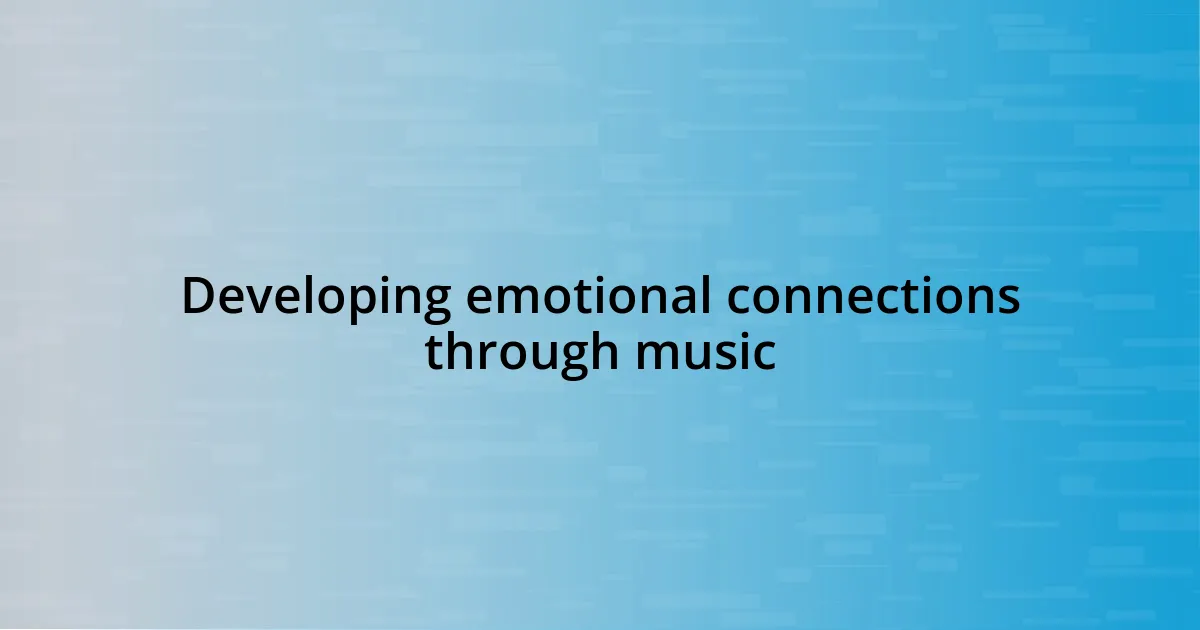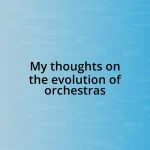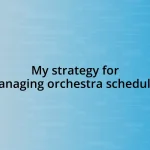Key takeaways:
- Live orchestra performances evoke profound emotional connections, allowing audiences to experience a range of feelings and memories.
- Understanding musical dynamics enhances appreciation for music, emphasizing how volume and intensity convey stories and emotions.
- Orchestral experiences foster cultural awareness, revealing how music reflects diverse traditions and connects individuals across different backgrounds.
- Lessons from orchestra performances, such as collaboration and perseverance, can be applied to personal growth and relationships.

Experiencing live orchestra performances
Attending a live orchestra performance can be a transformative experience. I still remember the first time I was enveloped by the sound of a full symphony filling the concert hall. It felt as though each note was weaving a story that resonated deep within me. Have you ever felt that rush of excitement as the conductor raises their baton? It’s as if time pauses for that brief moment, and all the anticipation comes crashing together in a beautiful crescendo.
One evening, I found myself sitting in a packed auditorium, the air buzzing with expectation. As the musicians took their places, I couldn’t help but notice the varying expressions on their faces—some were focused, while others radiated pure joy. I wondered how it felt for them to bring such complex compositions to life. When the music finally began, it transported me through different emotions—joy, nostalgia, and even melancholy—all within a single performance. It’s a reminder that music has the power to connect us, sometimes in ways words cannot.
Another standout moment for me was witnessing the magic of a live performance when the audience held its breath during a delicate solo. I recalled watching the violinist, her fingers dancing effortlessly over the strings, and it struck me how vulnerable yet powerful such moments can be. Isn’t it amazing how a simple chord can evoke such deep feelings? This experience reaffirmed my belief that live orchestra performances go beyond music; they are shared journeys that spark connections and reflections within us all.

Understanding musical dynamics deeply
Understanding musical dynamics deeply impacts how I perceive and appreciate music. Each time I attend an orchestra performance, I become more attuned to the subtle shifts in volume and intensity. I remember sitting in the audience one night as the conductor skillfully maneuvered through soft, delicate passages, and then suddenly unleashed a powerful fortissimo. It struck me how those variations can build tension and release it, weaving an expressive tapestry that encompasses a range of emotions.
The contrast between loud and soft passages is more than just an auditory experience; it tells a story. While listening to a symphony, I often think about how dynamics can convey feelings. For instance, during a performance of Mahler’s Symphony No. 2, a hauntingly soft segment drew me in completely. It felt as though the whole world faded away, and I was left in a space where only the music existed. This experience taught me that dynamics can evoke memories and feelings, transporting us back to moments in our lives.
I’ve begun to understand dynamics as an essential component of musical interpretation, igniting a deeper appreciation for the musicians’ skills. In a rehearsal, I witnessed a cellist discussing the varying levels of sound with the section. They emphasized how a subtle adjustment could drastically change the emotional impact of a passage. This interaction made me realize that dynamics are not merely technical nuances; they breathe life into the music and allow the audience to engage with it on a profound level.
| Dynamic Level | Emotional Impact |
|---|---|
| Piano | Creates a sense of intimacy or tenderness. |
| Forte | Conveys power, excitement, or struggle. |
| Mezzo-piano | Suggests calmness or serenity. |
| Mezzo-forte | Bridges between intensity and subtlety. |

Developing emotional connections through music
When I immerse myself in the world of orchestras, I often find that the emotional connections forged through music are some of the most profound experiences. I vividly recall the moment during a performance of Tchaikovsky’s “Swan Lake” when the strings played a particularly stirring passage. I felt a wave of nostalgia washing over me, pulling me back to my childhood memories of dance lessons and aspirations. It’s in these instances that I realize music can serve as a bridge to artfully intertwined emotions and memories, allowing us to explore parts of ourselves that we might not typically access.
- Emotional connections in music can lead to:
- Nostalgia: Triggering memories from the past.
- Empathy: Providing insight into others’ experiences.
- Joy: Elevating our spirits, sometimes unexpectedly.
- Catharsis: Offering a sense of relief through shared sorrow or passion.
Attending an orchestra can be quite personal for me. For example, watching the audience react to a heart-wrenching cello solo, I noticed how some listeners wept quietly while others smiled, lost in the sheer beauty of the sound. It struck me that within a single performance, everyone interprets the music through their lens of experiences and emotions. This diversity highlights music’s ability to connect us, transforming a simple concert into a communal journey that resonates deeply and uniquely for each individual.

Enhancing cultural appreciation and awareness
Attending orchestra performances has profoundly affected my cultural appreciation and awareness. I remember the first time I listened to a piece by an unfamiliar composer; it was Dvořák’s “New World Symphony.” As the melodies unfolded, I felt a connection to the cultural roots of another country, which sparked my curiosity about its history and the societal influences that shaped it. Isn’t it fascinating how music can offer a window into an entirely different world?
My journey through orchestral music has also opened my eyes to the rich tapestry of diverse cultures. During a concert that featured pieces from various traditions, I found myself captivated by the distinct styles and instruments used across different cultures. The experience highlighted just how deeply intertwined music is with cultural identity. I often ponder, how many stories are woven into a single musical score? This realization fosters not just appreciation but a genuine respect for the myriad ways people express their experiences through music.
Every performance acts as a dialogue—one that invites me to engage with the traditions and stories of others. After attending an international music festival, I was able to speak to musicians from different backgrounds, each sharing their unique stories and inspirations. This experience reaffirmed my belief that music transcends boundaries, creating a shared space where people from all walks of life can come together and celebrate their cultural heritage. In these moments, I cannot help but reflect on how much there is to learn from one another through the universal language of music.

Applying lessons to personal growth
One of the most significant lessons I’ve absorbed from orchestra performances is the art of collaboration. I remember a moment during a rehearsal when the conductor emphasized the importance of listening to each other. It struck me that this same principle applies to personal relationships; by actively listening to those around us, we create a harmonious environment where everyone feels valued. Have you ever considered how much stronger our connections could be if we approached our interactions with that same spirit of collaboration?
Beyond collaboration, I’ve also learned the value of perseverance in the face of challenges. There was a particularly tricky passage in a piece I played that pushed me to the edge of frustration. It took countless rehearsals and mistakes before I finally mastered it. That experience taught me an invaluable lesson: growth often comes from embracing difficulties, not avoiding them. Isn’t it comforting to know that each struggle can unveil a hidden strength within us?
Moreover, experiencing the balance of discipline and creativity in orchestral settings has profoundly impacted my personal growth. Each musician must practice diligently, yet express themselves uniquely during performances. This dichotomy reminds me that in pursuing my goals, I should strive for that same balance. How do we allow structure to guide us while leaving room for our individual flair? By applying this principle to my own work, I’ve found that it enhances both my productivity and joy in what I create.













